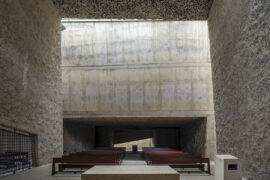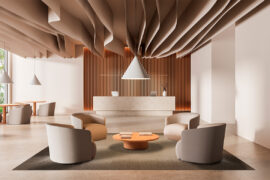Rising up from the banks of China’s Wu-Li Lake, Wuxi’s latest cultural landmark is an imposing Finnish design
September 12th, 2012
Wuxi, dubbed “Little Shanghai” for its proximity to the cosmopolitan city and its vigorous development in economy, is also a thriving centre for arts and culture – a fact underscored by its newest landmark on a manmade peninsula on the banks of Wu-Li Lake.


The Wuxi Grand Theatre is designed by PES-Architects from Finland. The impressive structure rises up a total of 50 metres like a mega sculpture from a terraced base.

Forming the main architectural gesture of the building are eight wings, which are, according to PES-Architects, also the most architecturally demanding aspect of the build.

Inside the steel wings are thousands of LED lights that change colour according to the character of the performances – made possible by perforated aluminium panels on the underside of the wings.

Another notable feature is the ’forest’ of 50 light columns, each 9 metres high, which begin from the main entrance square, serve as a support for the roof in the central lobby, and continue outside the lake entrance into the lake.


Bamboo, a local material, covers the Main Opera Auditorium. Over 15,000 solid bamboo blocks are used, all individually shaped according to acoustic needs and architectural considerations.


A Finnish influence is also evident in the 20,000 glass bricks inspired by Finnish nature, lakes and ice, which line the curved wall of the opera auditorium in the lakeside lobby.

The Wuxi Grand Theatre contains a wide variety of functions, but most notably, it houses the 1,680-seat Grand Theatre for classical and Chinese opera, ballet, and symphony orchestral music, and a Comprehensive Performance Hall with a capacity of 690 seats.
PES-Architects
pesark.com
INDESIGN is on instagram
Follow @indesignlive
A searchable and comprehensive guide for specifying leading products and their suppliers
Keep up to date with the latest and greatest from our industry BFF's!

Welcomed to the Australian design scene in 2024, Kokuyo is set to redefine collaboration, bringing its unique blend of colour and function to individuals and corporations, designed to be used Any Way!

London-based design duo Raw Edges have joined forces with Established & Sons and Tongue & Groove to introduce Wall to Wall – a hand-stained, “living collection” that transforms parquet flooring into a canvas of colour, pattern, and possibility.

Designed by architects Populous and Tyrrell Studio, construction has begun on the NSW Government’s $309 million redevelopment of Penrith Stadium led by John Holland Group.

Flo Power Hub provides cost-effective desktop access to three USB ports for easy and convenient charging of personal devices in the workplace.

After almost two decades of inspiring passion for design, Corporate Culture has distilled its identity into CULT. Aspirational yet inclusive, this new identity pays tribute to the religion of Design, and announces its first collaboration with Australian Designer Adam Goodrum.
Unlimited: Designing for the Asia Pacific has just announced the line up of speakers for the inaugural international event. Supported by the Queensland Government, Unlimited will feature a series of events exploring how design thinking can change your business, community and world via a series of workshops, talks, forums, exhibitions and events. Among the international […]
The internet never sleeps! Here's the stuff you might have missed

The World Architecture Festival has named The Holy Redeemer Church and Community Centre of Las Chumberas in La Laguna, Spain as World Building of the Year 2025, alongside major winners in interiors, future projects and landscape.

A stunning indoor space reveals artistry in every aspect, from outlook to underfoot.